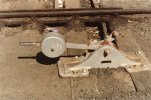JimmyB
Now retired - trains and fishing
Yep, that's where I think I saw itI think you’re right. I seem to remember seeing some when I watched the Journeys programme about the Isle of Mann Steam Railway the other day
Yep, that's where I think I saw itI think you’re right. I seem to remember seeing some when I watched the Journeys programme about the Isle of Mann Steam Railway the other day
I think there are quite a few 1:1 examples - the weight helpsThe IOM steam at Port Erin has push throughs, or so I am lead to believe. I am sure somebody will correct me if I am wrong
Good question, considering going myself next year - is this really thread driftBit of drift, but how did you travel there - air or sea?

Prime example of someone asking a question, and actually reading and taking note of the answers! No names mentioned.So overall, I think what folk are saying is that
live frogs aid certain locos to traverse points at slow speed, but
they require discipline in use to ensure “push throughs” don’t happen as this could/would cause a short circuit (depending on how the point blades and frog are wired).

Ok different issue. I assume you are not talking DCC?Sorry, one further question. When I connect the “feed” to the point frog and my isolating track, should I include a diode somewhere in the circuit? When I had a Massoth Reverse Loop module it came with diodes to connect into the feeds to the tracks and, although I installed them, I never really understood why they were needed. Is it to protect from surges or such like?
(I did do a Google on this but it didn’t help me much, I’m afraid.)
Thanks
Just to make clear, What Jon just described applies to analog track power only. This is the diode setup in the LGB analog reverse loop track section sets No. 1000K and the newer 10151.
I think the diodes Phil is referring to are those provided with the Massoth 8157001 (and LGB 55085) DCC reverse loop modules. These are diodes that can be optionally added to the sensor leads. The diodes lessen the susceptibility of the track sensor segments to false triggering.
But to answer Phil's question, no, in general you do not want to put diodes on the power feed to a live frog whether you are using analog or DCC track power.
Ok different issue. I assume you are not talking DCC?
With the points live frog you need a switch to swop the feed to the frog.
Straight ahead it comes from the curved rail.
Curved it comes the straight rail.
With DCC a ‘Frog Juicer’ does the same thing. EDIT DCC ONLY
Again assuming you are not talking DCC. The reverse loop module uses diodes to allow the positive feed to be whatever way you turn the controller. Thus when you stop the loco in the loop you needed to reverse the controller but the loco carried on in the same direction.
Yes, they’re the ones. As I’m DCC (when not battery) I‘ll leave diodes out of the picture!Just to make clear, What Jon just described applies to analog track power only. This is the diode setup in the LGB analog reverse loop track section sets No. 1000K and the newer 10151.
I think the diodes Phil is referring to are those provided with the Massoth 8157001 (and LGB 55085) DCC reverse loop modules. These are diodes that can be optionally added to the sensor leads. The diodes lessen the susceptibility of the track sensor segments to false triggering.
But to answer Phil's question, no, in general you do not want to put diodes on the power feed to a live frog whether you are using analog or DCC track power.
Absolutely, I agree Jon. I should have made clearer that I was referring to what you had written here:Actually with Live Frogs as stated in my middle sentence above applies to both Analogue and DCC.
The reverse loop module uses diodes to allow the positive feed to be whatever way you turn the controller. Thus when you stop the loco in the loop you needed to reverse the controller but the loco carried on in the same direction.
